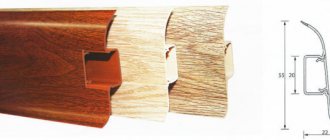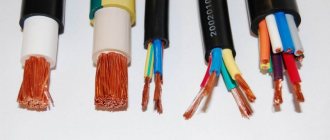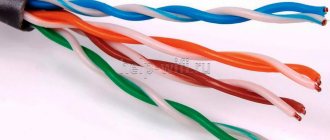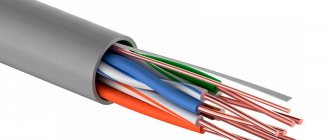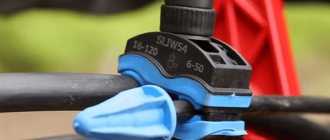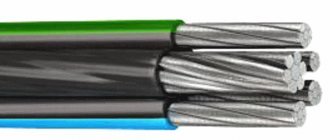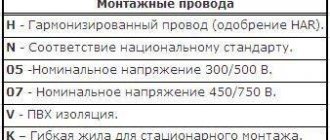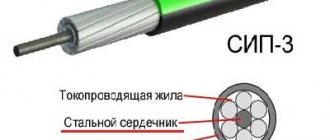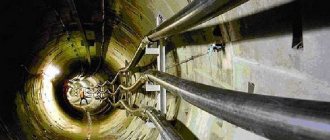Wires
Wires have a single uninsulated core or one or more insulated cores , covered with some material (except metal), winding or braided wire or fibrous substance. Let's consider two existing types of wires:
- Isolated. Such wires have a coating of rubber, cotton material, metal tape or plastic on top of the electrical insulation, which is necessary for protection from external factors and for sealing. Protected wires include APRF, APRN, PRVD, etc.
- Naked. Essentially, an unprotected wire is one that does not have an electrical insulation sheath (example - APPV, PPV, PRD, APRTO, etc.). This type is different in that the wire cores are not equipped with any insulating sheaths. AS, PS, PSO, A and other types of bare wires are often used for power lines installed in the air.
In addition to the types described, there is a separate subtype of wires - cord .
It consists of a wire of at least two insulated flexible conductors, the cross-section of which is limited to 1.5 mm. These strands are twisted or laid parallel to each other and covered with some kind of insulating material (not metal).
A little theory
Not all of its volume reaches the consumer of electromagnetic energy - during the movement, part of the energy is spent on heating the wire . The amount of losses depends on the following factors:
- magnitude of flowing current
- wire resistance
The greater the thickness (that is, its cross-section), the lower the value of its resistance and loss of permissible energy for heating.
Thus, when a long-term permissible current or, in other words, a high voltage current flows through a wire with a small cross-section, it will seriously heat up and have a thermal effect on the insulating material. If the permissible long-term current for cables constantly exceeds the required values by several times, then the insulation will completely lose all its protective properties and become unusable, and the functioning of the conductors in the system will malfunction. In other words, a short circuit will occur .
A correctly designed electrical wiring design for long-term permissible current will help reduce energy losses due to heating of wires. This will significantly help save a considerable amount of money that goes towards paying utility bills.
How is a wire different from a cable?
Quite often these concepts are replaced by one another . And this is not surprising. It is often very difficult for a non-professional to distinguish these two products due to their external similarity. However, the wire is a system consisting of the following elements:
- one bare core
- one or more cores covered with insulating material
On top of all the cores, based on the conditions of laying and using the wire, a non-metallic sheath, a braid using fibrous materials, a winding or a layer of wire is created. All wires currently on the market come in two types - bare and insulated.
Bare wires are elements whose conductive cores do not have a protective or insulating coating. The main area of application for these wires is overhead power lines.
Insulated wires are elements with conductive conductors coated with insulation. In the vast majority of cases, either rubber or plastic is used as an insulating material.
On top of the insulation of such wires there is a braid made of cotton material or a sheath of plastic or rubber.
Wire classification
Insulated wires, in turn, can be classified into two groups - protected and unprotected .
Protected ones got their name due to the presence of an insulating shell material on top of them. Its main function is to seal and provide reliable protection of the wire from a variety of external factors. Protected products include products marked APRN, PRVD and APRF.
Bare insulated wire is a system in which there is no sheath over the insulating material. Such wires are the elements APRTO, PRD, APPV, PPV, APPR, etc.
A cable consists of one or more insulated conductors that are twisted together. As a rule, they are placed in a special shell - made of rubber, plastic or metal . The main purpose of the sheath is to withstand the permissible long-term current for cables and to provide reliable protection of the insulating material of the current-carrying conductors from external influences. These can be sun rays, moisture, chemical compounds and mechanical damage.
Cables
The cable consists of one or more cores twisted together and covered with plastic or rubber insulation. The cable may also have a metal coating. The shell performs a protective function from the effects of negative factors - moisture, chemical reagents, light rays. In addition, the coating protects the cores from mechanical damage.
As a rule, cables are laid underground, in the air, or at the bottom of reservoirs. These products are divided into several groups:
- Communication. Necessary for the operation of public address and telephony systems.
- Optical and radio frequency. Designed to transport electricity and transmit signals in a specific range or at certain radio frequencies. Such cables are used to install the Internet, location equipment, and telephone communications.
- Power. This type is needed to transport electricity from source to consumer. As a rule, power cables are installed permanently, forming different power lines. They are usually made from copper and aluminum.
- Control cable. They are used to create control circuits in complex structures and machines, as well as for lighting.
- Installation/control. Needed for inter-device installation of electrical equipment. The conductors for installation cables are made from a special copper connection. The key difference from other species is the ability to withstand elevated temperatures.
The difference between cables and wires depending on the core material
Cores of wires and cables for specialized purposes can be made of various metals, but aluminum and copper are mainly used in electrical engineering. Each of them has its own specific properties, advantages and disadvantages, which must be taken into account when selecting a core material for a specific purpose.
Aluminum conductors
The invention of a relatively inexpensive method for extracting aluminum made a revolution in the global development of electrification, because in terms of electrical conductivity this metal ranks fourth, behind only silver, copper and gold. This made it possible to reduce the cost of production of wires and cables as much as possible and make universal electrification a reality.
Such electrical wires and their types are distinguished by their low cost, chemical resistance, high level of heat transfer and low weight - they have determined the mass of electrification in industrial and domestic conditions for more than half a century.
In light of the relatively recent dominance of aluminum in the wire market, it may seem strange to the uninitiated that the provisions of the PUE prohibit the use of this material in everyday life. More precisely, you cannot use aluminum wires with a cross-section of less than 16 mm², and these are the most common of them for installing home electrical wiring. To understand why there is a ban on the use of these wires, you can familiarize yourself with their advantages and disadvantages.
+ Advantages of aluminum wires
- Lighter than copper.
- Significantly cheaper.
— Disadvantages of aluminum wires
- Aluminum conductors with a cross-section of up to 16 mm² can only be single-wire, which means they can only be used for laying stationary wiring and without bending at an acute angle. All flexible wires and cables have always been made of copper.
- The chemical resistance of aluminum is determined by the oxide film that forms when it comes into contact with air. Over time, with constant heating of the contact due to the flow of electric current through it, this film deteriorates electrical conductivity, the contact overheats and fails. That is, aluminum wires require additional maintenance, and the contacts through which powerful currents pass are coated with a special lubricant.
- Amorphous material - if you clamp two aluminum wires together, the contact will weaken over time, as the aluminum will partially “leak out” from under pressure.
- Soldering can only be carried out using special tools, and welding can be performed in a chamber with an inert gas.
- Good electrical conductivity is observed only in pure aluminum, and impurities inevitably remaining during production worsen this indicator.
As a result, aluminum is a good choice if you need to save money here and now, but in the long run its use will be more expensive due to its relatively short service life and the need for regular maintenance. For this reason and additional safety reasons, the PUE strictly prohibits using it for laying new power lines.
Product marking
Each product has a specific marking consisting of letters, numbers and color symbols. It indicates not only belonging to a certain group, but also the material, diameter, number of cores, scope of application, etc.
The first letter indicates the material of manufacture (with the exception of the letter “A” - it indicates that the core is made of aluminum):
- B – PVC;
- P – polyethylene;
- PV – vulcanizing polyethylene;
- PS – self-extinguishing polyethylene, etc.
The second letter denotes the insulating material : B – PVC, R – rubber, etc. Each subsequent letter has a meaning. For example, the marking AVVGng 3x2.5 is deciphered as follows:
- “A” – aluminum (core material);
- “B” – PVC core insulation;
- “B” – the general shell is also made of PVC;
- “G” – no armor;
- “ng” – does not burn;
- “3x2.5” - the product contains three cores, their cross-section is 2.5 mm2.
Since each core is enclosed in an individual sheath, this is a cable decoding. If the marking contained the letter “E”, this would mean that the cable is equipped with a screen. “P” indicates the presence of rubber protection, “B” indicates armor from aggressive chemicals and combustion. The content of the letter “Ш” in the marking indicates that the protective layer of the cable has the form of a hose.
Wire markings have different meanings for some symbols. Thus, a product of the PuGV brand is an installation wire coated with PVC and having good flexibility. Since there are so many different combinations of letters in the markings, it can be difficult to decipher. Then it is better to turn to special reference books or search for information on the Internet.
Marking of cable products
The alphanumeric designations that make up the name of the cable display all the most important information about its characteristics: what the core and insulation are made of, purpose and design differences, number and cross-section of cores, additional features. Some letters may be missing, thereby indicating some general parameter.
Letter 1. Can only be “A” - indicates an aluminum core. If the marking begins with any other letter, then the first one is missing and the cable is copper.
Letter 2. Shows what the cable is intended for:
- M – mounting
- MG – flexible mounting
- P (U) or Ш – installation
- K – control
The absence of the second letter indicates that this is a power cable.
Letter 3. Material and type of internal insulation. The most common designations:
- P – polyethylene
- B or BP – polyvinyl chloride
- R – rubber
- N or NR - non-flammable rubber
- C – fiberglass
- K - nylon
- D – double winding
- Ш – polyamide silk
- E – shielded
Letter 4. Design features:
- G – flexible
- K – armored, braided with round wire
- B – armored with ribbons
- O - braided
- T – laid in pipes
Add. Letters - lowercase Cyrillic or Latin capital letters, indicate the features of the cable subtypes:
- h – filled
- ng – non-flammable
- HF – produces little smoke when burning
- LS – when burning they emit little gas
Number 1. Number of cores.
Number 2. Cross-section of cores.
Number 3. The rated voltage for which the wire is designed.
These are not all possible designations - only those that are used in widely used cables and wires for household use. If necessary, you can look at the tag for a decoding or ask the seller.
Example of marking decoding: AVVGng 3x2.5
- A - cable with aluminum core;
- B - insulation of each core from PVC;
- B - PVC outer sheath;
- G - flexible cable;
- ng - the shell does not support combustion;
- 3 - three cores;
- 2.5 - core cross-section.
Using cables and wires
Unlike wire, cable is widely used in special conditions because it has stronger protection against any damage. Underwater and underground communications are established only through cables. In addition, this type of product is used in fire hazardous facilities, rooms with high humidity, etc.
Wires are used, as a rule, in electrical distribution boxes and other electrical devices, as wiring in residential and non-residential premises.
It is very important to be able to distinguish between wires and cables, since incorrect operation can be dangerous.
Core insulation and cable sheath
Insulating the conductors protects the cable from external negative factors and prevents the influence of differently directed phases relative to each other. In addition to the separate coating of each core, they are also enclosed in a common shell.
The wire insulation in the cable is usually made of vinyl, cross-linked polyethylene or PVC. The top covering is made of rubber, PVC and cross-linked polyethylene.
Note! Excellent performance qualities of the casings, such as resistance to direct solar ultraviolet radiation, mold, fungal formations, and combustion, ensure that communications remain in working order for many years of service.

